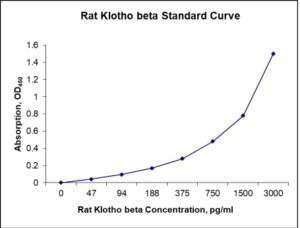Nori Rat Klotho beta ELISA Kit
$461.00 – $832.00
This ELISA kit is for quantification of klotho beta in rat. This is a quick ELISA assay that reduces time to 50% compared to the conventional method, and the entire assay only takes 3 hours. This assay employs the quantitative sandwich enzyme immunoassay technique and uses biotin-streptavidin chemistry to improve the performance of the assays. An antibody specific for KL has been pre-coated onto a microplate. Standards and samples are pipetted into the wells and any KL present is bound by the immobilized antibody. After washing away any unbound substances, a detection antibody specific for KL is added to the wells. Following wash to remove any unbound antibody reagent, a detection reagent is added. After intensive wash a substrate solution is added to the wells and color develops in proportion to the amount of KL bound in the initial step. The color development is stopped, and the intensity of the color is measured.
Alternative names for klotho beta: KL
This product is for laboratory research use only not for diagnostic and therapeutic purposes or any other purposes.
- Description
- How Elisa Works
- Product Citation
- Reviews (0)
Description
Nori Rat Klotho beta ELISA Kit Summary
Alternative names for klotho beta: KL
| Assay Type | Solid Phase Sandwich ELISA |
| Format | 96-well Microplate or 96-Well Strip Microplate |
| Method of Detection | Colorimetric |
| Number of Targets Detected | 1 |
| Target Antigen Accession Number | Q9Z2Y9 |
| Assay Length | 3 hours |
| Quantitative/Semiquantitative | Quantitative |
| Sample Type | Plasma, Serum, Cell Culture, Urine, Cell/Tissue Lysates, Synovial Fluid, BAL, |
| Recommended Sample Dilution (Plasma/Serum) | No dilution for sample <ULOQ; sufficient dilution for samples >ULOQ |
| Sensitivity | 9 pg/mL |
| Detection Range | 47-3000 pg/mL |
| Specificity | Rat Klotho beta |
| Cross-Reactivity | < 0.5% cross-reactivity observed with available related molecules, < 50% cross-species reactivity observed with species tested. |
| Interference | No significant interference observed with available related molecules |
| Storage/Stability | 4 ºC for up to 6 months |
| Usage | For Laboratory Research Use Only. Not for diagnostic or therapeutic use. |
| Additional Notes | The kit allows for use in multiple experiments. |
Standard Curve
Kit Components
1. Pre-coated 96-well Microplate
2. Biotinylated Detection Antibody
3. Streptavidin-HRP Conjugate
4. Lyophilized Standards
5. TMB One-Step Substrate
6. Stop Solution
7. 20 x PBS
8. Assay Buffer
Other Materials Required but not Provided:
1. Microplate Reader capable of measuring absorption at 450 nm
2. Log-log graph paper or computer and software for ELISA data analysis
3. Precision pipettes (1-1000 µl)
4. Multi-channel pipettes (300 µl)
5. Distilled or deionized water
Protocol Outline
1. Prepare all reagents, samples and standards as instructed in the datasheet.
2. Add 100 µl of Standard or samples to each well and incubate 1 h at RT.
3. Add 100 µl of Working Detection Antibody to each well and incubate 1 h at RT.
4. Add 100 µl of Working Streptavidin-HRP to each well and incubate 20 min at RT.
5. Add 100 µl of Substrate to each well and incubate 5-30 min at RT.
6. Add 50 µl of Stop Solution to each well and read at 450 nm immediately.
Background:
Klotho is an enzyme that is encoded by the KL gene.[1] It is a type-I membrane protein that is related to β-glucuronidases. Reduced production of this protein has been observed in patients with chronic renal failure (CRF), and this may be one of the factors underlying the degenerative processes (e.g., arteriosclerosis, osteoporosis, and skin atrophy) seen in CRF. Also, mutations within this protein have been associated with ageing and bone loss.[2] Transgenic mice that overexpress Klotho live longer than wild-type mice.[3] Klotho is a transmembrane protein that, in addition to other effects, provides some control over the sensitivity of the organism to insulin and appears to be involved in aging. Its discovery was documented in 1997 by Kuro-o et al.[4] The Klotho protein is a novel β-glucuronidase capable of hydrolyzing steroid β-glucuronides. Klotho protein has been shown to be a circulating factor detectable in serum that declines with age.[5] Klotho-deficient mice manifest a syndrome resembling accelerated canine aging and display extensive and accelerated arteriosclerosis. Additionally, they exhibit impaired endothelium dependent vasodilation and impaired angiogenesis, suggesting that Klotho protein may protect the cardiovascular system through endothelium-derived NO production. The mechanism of action of klotho is not fully understood, but it changes cellular calcium homeostasis, by both increasing the expression and activity of TRPV5 and decreasing that of TRPC6.[6]
References
- Matsumura Y, et al. (1998)Biochem. Biophys. Res. Commun. 242 (3): 626–30.
- Arking DE, (2002). Proc. Natl. Acad. Sci. U.S.A. 99 (2): 856–61.
- Kurosu, H.; et al. (2005). Science 309 (5742): 1829–1833.
- Kuro-o M, (1997). Nature 390 (6655): 45–51.
- Xiao NM, et al. (2004). Chin. Med. J. 117 (5): 742–7.
- Huang, C. L. (2010). Kidney International 77 (10): 855–860.
Be the first to review “Nori Rat Klotho beta ELISA Kit”
You must be logged in to post a review.




























Reviews
There are no reviews yet.